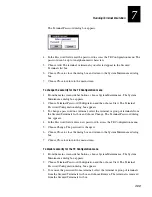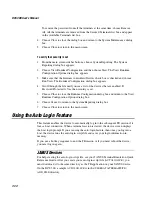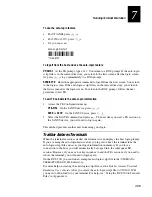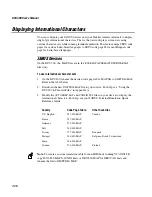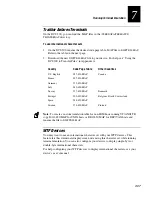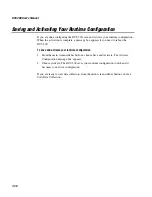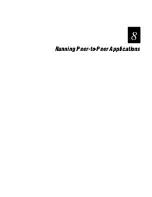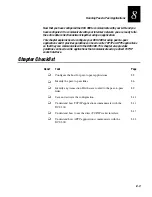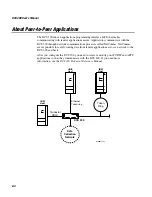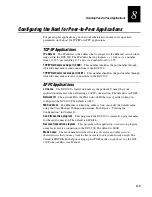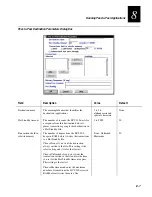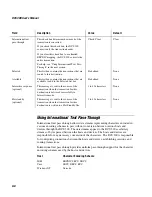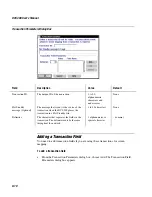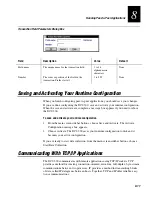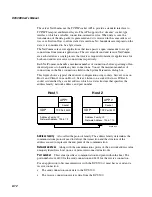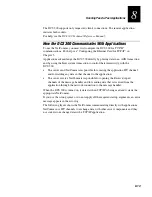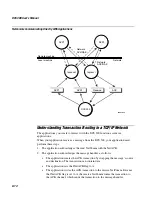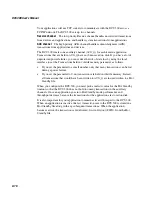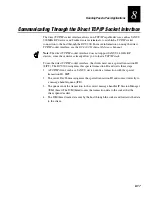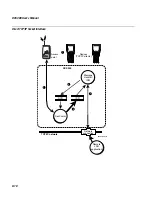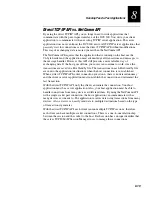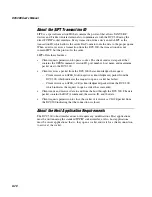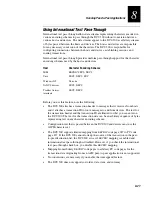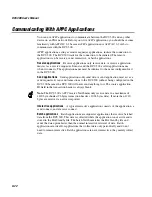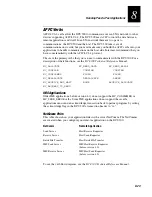
Running Peer-to-Peer Applications
8-9
8
Character Encoding Scheme Table (continued)
Host
Character Encoding Scheme
JANUS devices
SBCS, DBCS
Trakker Antares
terminals
SBCS, DBCS
Before you use this feature, note the following:
•
The DCS 300 attaches a transaction header to messages that it receives from hosts
and it attaches a transaction ID to route messages to and from devices. The
characters in the transaction header and the transaction ID are limited by what you
can type on the DCS 300. The characters for the transaction data can be an arbitrary
sequence of bytes representing text in any character encoding scheme.
•
Configuration text that is passed between the DCS 300 and devices must use the
ASCII character set.
•
The DCS 300 still supports limited mapping from
EBCDIC
code page 037 to PC
code page 437. If the DCS 300 cannot look up the source of the transaction in the
peer-to-peer destination list, the DCS 300 assumes that
EBCDIC
mapping is enabled
and international text pass-through is disabled. However, if you check the
international text pass-through check box, you disable this
EBCDIC
mapping.
•
Mapping from arbitrary
EBCDIC
code pages to arbitrary PC code pages for the
transaction data originating from an APPC peer-to-peer application is not
supported.
•
No conversions are necessary if you enable the time append feature.
•
The DCS 300 does not support sort order, date, item, and currency.
Adding a Transaction
You need to define all transaction IDs that you want the DCS 300 to route to the
destinations.
To add a transaction
•
From the Peer-to-Peer Destination Parameters dialog box, choose Add. The
Transaction Parameters dialog box appears.
Summary of Contents for DCS 300
Page 1: ...P N 067296 005 User s Manual DCS300 ...
Page 4: ...DCS 300 User s Manual blank ...
Page 16: ...DCS 300 User s Manual ...
Page 22: ...DCS 300 User s Manual ...
Page 23: ...Getting Started 1 ...
Page 24: ...DCS 300 System Manual blank ...
Page 42: ...blank ...
Page 43: ...Learning About the DCS 300 2 ...
Page 44: ...DCS 300 User s Manual blank ...
Page 68: ...blank ...
Page 69: ...Connecting to the Upline Network 3 ...
Page 70: ...DCS 300 System Manual 3 2 blank ...
Page 94: ...blank ...
Page 95: ...Connecting to the Intermec RF Network 4 ...
Page 96: ...DCS 300 System Manual blank ...
Page 134: ...blank ...
Page 135: ...Connecting to the 9180 and the Intermec CrossBar Network 5 ...
Page 136: ...DCS 300 System Manual blank blank ...
Page 158: ...DCS 300 System Manual blank ...
Page 159: ...Running Data Collection Browser 6 ...
Page 160: ...DCS 300 System Manual blank ...
Page 171: ...Running Terminal Emulation 7 ...
Page 172: ...DCS 300 System Manual blank ...
Page 209: ...Running Peer to Peer Applications 8 ...
Page 210: ...DCS 300 System Manual blank ...
Page 232: ...blank ...
Page 233: ...Running Terminal Sessions 9 ...
Page 234: ...DCS 300 System Manual blank ...
Page 258: ...DCS 300 System Manual 9 26 blank ...
Page 259: ...Running Screen Mapping 10 ...
Page 260: ...DCS 300 System Manual 10 2 blank ...
Page 269: ...Running Screen Mapping 10 11 10 Screen 3 Screen 4 Main Host Screen Screen 5 ...
Page 333: ...Troubleshooting 11 ...
Page 334: ...DCS 300 System Manual blank ...
Page 372: ...blank ...
Page 373: ...Specifications and Other Helpful Information A ...
Page 374: ...DCS 300 System Manual B 2 blank ...
Page 391: ...Upgrading the DCS 300 and Devices B ...
Page 392: ...DCS 300 System Manual blank ...
Page 411: ...How the DCS 300 Routes Transactions C ...
Page 412: ...DCS 300 System Manual blank ...
Page 430: ...blank ...
Page 431: ...Index I ...
Page 432: ...DCS 300 System Manual I 2 blank ...

